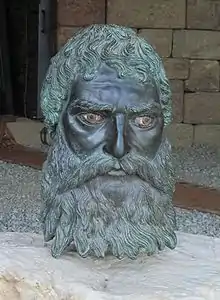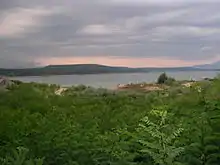Seuthopolis (Ancient Greek: Σευθόπολις) was an ancient hellenistic-type[1] city founded[2] by the Thracian king Seuthes III between 325–315 BC which was the capital of the Odrysian kingdom.[3]
Its ruins are now located at the bottom of the Koprinka Reservoir near Kazanlak, Stara Zagora Province, in central Bulgaria.
Several kilometres north of the city is the Valley of the Thracian Rulers where many magnificent royal tombs are located.

Seuthopolis was not[4] a true polis, but rather the seat of Seuthes and his court. His palace had a dual role, functioning also as a sanctuary of the Cabeiri, the gods of Samothrace.[5] Most of the space within the city was occupied not by homes but by official structures, the majority of the people living outside the city. It had Thracian and Greek populace.[6] In 281 BC it was sacked by Celts.[7]
The dual role of Seuthes' palace (royal court and sanctuary) indicates that Seuthes was a priest–king: the high priest of the Cabeiri among the Odrysian Thracians. According to Seuthopolis’ sign, the sanctuary of Dionysius/Sabazios was situated on the square.
The cemetery of Seuthopolis included a number of brick tholos tombs, some covered by tumuli, in which the upper-class were interred, sometimes along with their horses. The less affluent were cremated, with modest grave goods laid alongside.

The ruins of the city were discovered and excavated in 1948[8] by Bulgarian archeologists during the construction of the Georgi Dimitrov (later renamed Koprinka) Reservoir. However, it was decided to continue with the construction and flood the dam, leaving Seuthopolis at its bottom. Despite the importance of the discovery, the government gave the archaeologists 6 years to research and preserve as much of the city as they could.[9]
One of the most important archaeological finds is the so-called "Great inscription" found in 1953 in the palace-citadel. It is written in Greek, which indicates that Thracians were already hellenised in the 3rd century BC.
In 2005, Bulgarian architect Zheko Tilev proposed a project to uncover, preserve and reconstruct the city of Seuthopolis (the best-preserved Thracian city in Bulgaria) by means of a dam wall surrounding the ruins in the middle of the dam, enabling the site's inscription as a UNESCO World Heritage Site and making it a tourist destination of world importance. Tourists would be transported to the site by boats. The round wall, 420 metres in diameter, would enable visitors to see the city from 20 metres above and would also feature "hanging gardens", glass lifts, a quay, restaurants, cafés, shops, ateliers, etc. It would be illuminated at night.
The project was donated by the architect to Kazanlak municipality and funds are being raised to begin construction. According to Tilev, it would cost minimum €50 million.

Sevtopolis Peak on Greenwich Island in the South Shetland Islands, Antarctica is named for Seuthopolis.

See also
References
- ↑ Europe Between the Oceans: 9000 BC – AD 1000 by Barry W. Cunliffe, 2008,page 331,""... The most sophisticated was the capital, Seuthopolis, founded by the Odrysian king Seuthes III in c.32o BC. The town was laid out entirely in the style of a Hellenistic city...""
- ↑ A History of the Hellenistic World: 323 - 30 BC R. Malcolm Errington, 2008,"...in founding a city which he named after himself, Seuthopolis (SEG 42, 661). ..."
- ↑ An Inventory of Archaic and Classical Poleis: An Investigation Conducted by The Copenhagen Polis Centre for the Danish National Research Foundation by Mogens Herman Hansen,2005,page 1336,"Seuthopolis founded c.325-315"
- ↑ An Inventory of Archaic and Classical Poleis: An Investigation Conducted by The Copenhagen Polis Centre for the Danish National Research Foundation by Mogens Herman Hansen,2005,page 888,"It was meant to be a polis but this was no reason to think that it was anything other than a native settlement"
- ↑ The Princeton Encyclopedia of Classical Sites (eds. Richard Stillwell, William L. MacDonald, Marian Holland McAllister),A Thracian city near the village of Koprinka. It was founded at the end of the 4th c. B.C. by Seuthes III. The large quantity of material discovered during the excavation has shown that Seuthopolis was not only a center of production, but also of commerce. The city rises on a terrace circumscribed on three sides by the Tundza and by one of its tributaries. It was a fortified city of ca. 5 ha with a pentagonal circuit wall 2 m thick and 890 m in perimeter, with a quadrangular tower at each angle. At the N, between two towers, is the principal gate; and at the south are two gates between bastions. The wall is constructed of clay bricks and wood on stone foundations. The city's orthogonal plan is regular, with two large arteries that lead from the gates to the center. The agora is in the NW sector. In the NE zone is a walled and towered trapezoidal area within which is enclosed the palace of the prince and the Sanctuary of the Great Gods of Samothrace. In the houses, which are built with rooms around a court, has been found a type of plaster. Elements of porticos have been found and upper galleries of wood. The houses were furnished with wells and drainage systems with a channel in the center of the street. The influence of Hippodamos is evident, though the democratic distribution of living quarters is lacking. Seuthes III built his city on the site of an earlier settlement, and he also followed the Hellenistic fashion of the Diadochi in giving it his own name. Greek influence is prevalent in the urban elements cited and in decoration such as antefixes, stucco, and incrustation, and in the use of the Doric capital
- ↑ An Inventory of Archaic and Classical Poleis: An Investigation Conducted by The Copenhagen Polis Centre for the Danish National Research Foundation by Mogens Herman Hansen,2005,page 888
- ↑ The Ancient Celts by Barry W. Cunliffe,ISBN 0-14-025422-6,2000,page 172
- ↑ The Hellenistic Settlements in Europe, the Islands, and Asia Minor by Getzel M. Cohen,1996," The existence of Seuthopolis in Thrace was not known until 1948"
- ↑ Explore the Valley of Thracian Kings – Bulgaria's Thracian Heritage https://www.rosefestivalkazanlak.com/valley-thracian-kings-bulgarian-heritage/#seuthopolis